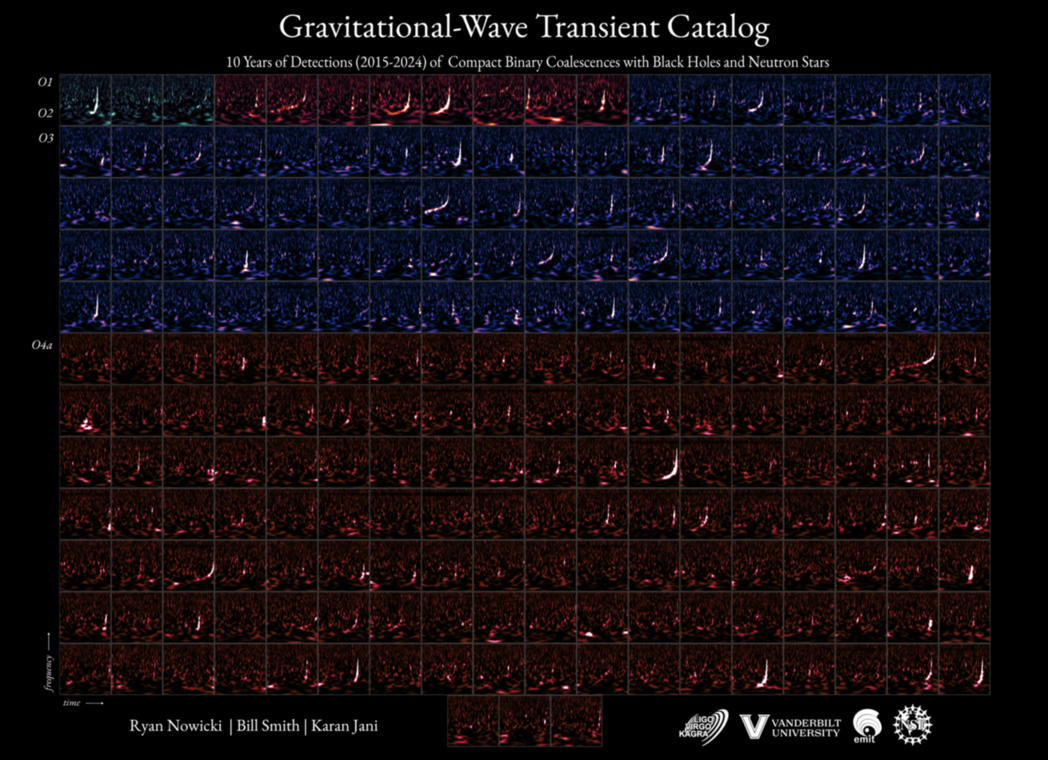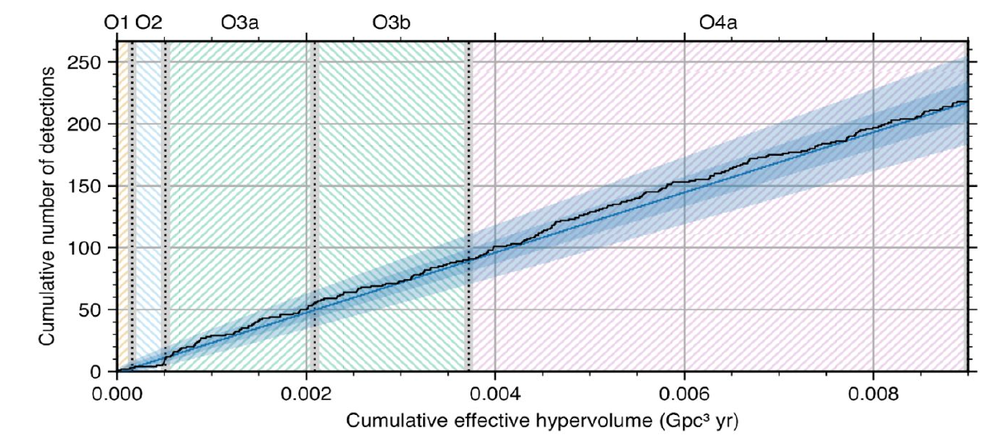Astronomy Object of the Month: 2025, October
< previous Archive next >
GWTC-4.0: Observations from Part I of the 4th LIGO-VIRGO-KAGRA campaign
In August 2025, the LIGO-Virgo-KAGRA (LVK) Collaborations released the interferometric strain data from the first part of the
fourth observing run (O4a), which ran from May 2023 to January 2024. In this data, we have discovered 128 new confident
gravitational-wave signals originating from merging black holes and neutron stars. Alongside the strain data release,
we publish version 4.0 of the Gravitational Wave Transient Catalog (GWTC-4.0), which contains lists of the candidate signals
and measurements of their properties.

Illustration (1) Coalescences of binary black hole and neutron star systems detected between 2015 and 2024 (source: LVK consortium).
The GW transient catalog is cumulative - in other words, GWTC-4.0 contains not only the new results observed in O4a but also all past catalogs. We can figure out the 4-dimensional volume in both time and space that the detectors have observed (we call this 'hypervolume' because it's a volume in more than three dimensions) by simulating signals and seeing if they are recovered, and then combining this information with details on the duty cycle of the detectors. In Illustration 2, we plot an approximation to this hypervolume against the cumulative number of detections with a probability of astrophysical origin greater than 50%. This shows how many signals were detected in each observing run and visualizes that in O4a, we have more than doubled the number of observed signals! The bands in the figure represent the uncertainty: while many candidates haveprobability of astrophysical origin very close to 100%, those with a probability of 50% are just as likely to be a spurious noise fluctuation. Therefore, the bands capture how uncertain we are about the number of observed events.
The GWTC-4.0: Methods for identifying and characterising gravitational-wave transients paper provides the details of the methodology used to produce GWTC-4.0. Starting with the development of theoretical waveform models for colliding black holes and neutron stars, we then move on to discuss the search pipelines that produce candidate lists. Each candidate is then subjected to data quality and candidate vetting before undergoing parameter estimation to understand the properties of the source and waveform consistency tests to validate the underlying assumptions.
The study discovered 128 new signals with a probability of astrophysical origin above 50%. This brings the total number of candidates within the GWTC to 218 and doubles the size of the catalog! We’re presenting a detailed analysis86 of these new signals in this catalog. Making so many new detections has been enabled by increases in the sensitivitythe detectors themselves and developments in the analysis techniques we use to dig the signals out of noise. Detections include typical coalescences of binary black hole systems, which detectors identify quite well, and entirely new "mixed" systems of black holes and neutron stars, which are different from anything which we’ve seen before.

The cumulative number of detections (candidates found with a probability of being astrophysical greater than 50%) against the approximate space-time hypervolume surveyed by the detectors (source: LVK consortium).
During O4, we have produced (as fast as possible) online public alerts on likely candidates. This enables other astronomers to perform follow-up observations to search for any light from the candidates. There were 1697 alerts in O4a, of which 82 were deemed highly likely to be astrophysical and did not have any data quality issues.
Two of the catalog members seem to have been produced by black holes merging with neutron stars. Signals like these are very interesting because, in comparison to mergers between black holes, which involve little or no “real” matter, the presence of matter from the neutron star can potentially be measured in the signal. For the two signals, we didn’t manage to detect any of these effects, but the more signals like these that we see, the more likely it is we’ll eventually be able to measure matter effects. And although no new double neutron star systems were found, some very interesting likely mixed neutron star–black hole systems and new events with total masses greater than 150 solar masses were discovered!
GWTC-4.0 doubles the number of known gravitational wave signals. This is a great achievement and a testament to the many improvements to the detectors. The new signals provide us with many new insights about black holes and neutron stars and will generate great excitement within the community, enabling a vast array of new studies.
Introductory article to the research topic
Original publication: LIGO-Virgo-KAGRA consortium, GWTC-4.0: Updating the Gravitational-Wave Transient Catalog with Observations from the First Part of the Fourth LIGO-Virgo-KAGRA Observing Run, the Astrophysical Journal Letters Focus Issue on the Gravitational Wave Transient Catalog (August 2025).
The research described is part of the research topics conducted at the Department of High Energy Astrophysics of the Astronomical Observatory of the Jagiellonian University in Kraków. The following scientists from OAUJ are participating in international gravitational wave research: Prof. M. Ostrowski, Eng. J. Kubisz, and Prof. Ł. Stawarz.
|
Łukasz Stawarz Astronomical Observatory Jagiellonian University L.Stawarz [at] oa.uj.edu.pl |


